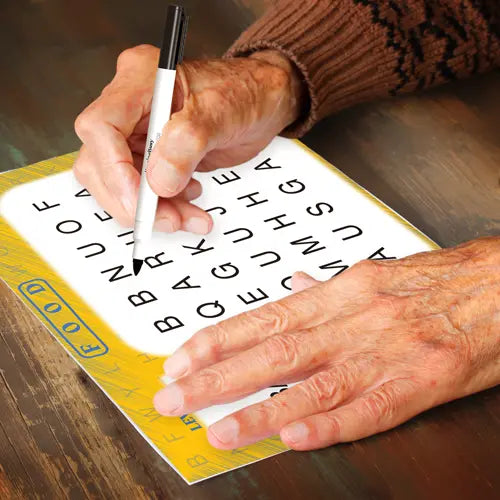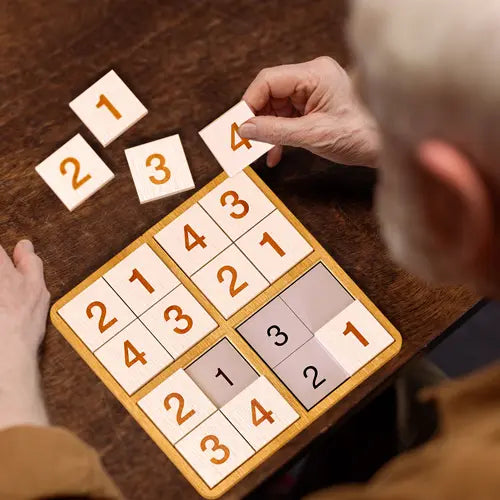
Communicating with someone who has dementia can be a difficult and emotional experience. Dementia is a condition that affects a person's memory, language, and decision-making skills. This can make it challenging to understand and connect with them.
But don't worry, we've got some simple strategies that can help you communicate effectively with your loved one or patient! With a little patience and empathy, you can make a big difference in their quality of life.
Tips for Preparing to Communicate with Someone with Dementia
Communicating with someone who has dementia can be challenging, but there are a few simple strategies you can use to prepare yourself for the conversation. Here are some tips to keep in mind:
1. Approach them in a calm and friendly manner
Try to create a peaceful environment free from distractions or loud noises that could cause confusion or agitation.
2. Establish eye contact and use their name when addressing them
This can help them feel more at ease and connected to the conversation.
3. Speak slowly and clearly to make it easier for them to understand you
Avoid using complex words or phrases that may confuse them.
4. Be patient and allow them time to respond
Avoid interrupting or finishing their sentences for them, as this can be frustrating and may cause them to withdraw from the conversation.
By following these simple tips, you can create a positive communication experience with your loved one or patient with dementia.
Tips for Effective Communication with Someone with Dementia
Communicating with someone who has dementia can be challenging, but there are a few simple strategies you can use to make it easier and more effective. Here are some tips to keep in mind:
1. Be Patient and Understanding
Individuals with dementia may need more time to process what you are saying or to find the right words to express themselves. Give them the time they need, and avoid interrupting or finishing their sentences for them.
2. Speak Slowly and Clearly
Use simple language and short sentences to make it easier for the person to understand you. Avoid using complex words or phrases that may confuse them.
3. Be Present and Engaged in the Conversation
Give the person your undivided attention, and try to make eye contact to show that you are listening. Use positive body language, such as smiling or nodding, to encourage them to continue speaking.
4. Use Nonverbal Cues to Support Your Message
If the person is having difficulty understanding what you are saying, try using gestures or pointing to objects that may help clarify your message.
5. Avoid Distractions and Noise
Find a quiet and comfortable place to talk, free from distractions such as loud music or television. This can help the person focus on the conversation and reduce confusion.
6. Be Respectful and Empathetic
Remember that individuals with dementia may feel frustrated, confused, or anxious. Show empathy and understanding, and be respectful of their feelings and experiences.
By following these tips, you can help make communication easier and more meaningful for both you and your loved one or patient with dementia.
Tips on Listening When Communicating with Someone with Dementia
Listening is an essential component of effective communication, especially when it comes to communicating with someone with dementia. Here are some tips on how to listen effectively:
1. Be attentive and focus on the person speaking
Pay close attention to what they are saying and avoid getting distracted by other things in the environment.
2. Listen for emotions as well as words
Individuals with dementia may struggle to express themselves clearly, so pay attention to their tone of voice, facial expressions, and body language to get a better sense of how they are feeling.
3. Avoid interrupting or correcting them
Allow the person to finish what they are saying before responding. Avoid correcting them or contradicting their statements, as this can cause frustration and confusion.
4. Use open-ended questions
Instead of asking yes or no questions, try using open-ended questions that encourage the person to share more information about how they feel or what they think.
5. Repeat back what you heard
After listening carefully, repeat back what you heard in your own words. This can help clarify any misunderstandings and show that you are truly listening.
By following these tips on listening, you can create a more positive communication experience for both you and your loved one or patient with dementia.
Being Patient When Waiting for a Response
When communicating with someone who has dementia, it's important to be patient when waiting for a response. It may take them longer to process what you've said and find the right words to respond.
Avoid rushing them or trying to finish their sentences for them, as this can cause frustration and anxiety. Instead, give them the time they need to gather their thoughts and respond in their own time.
Remember that communication is a two-way street, and allowing the person with dementia to express themselves at their own pace can help foster a more positive and meaningful conversation.
Using Nonverbal Cues to Support Communication
Nonverbal cues can be a powerful tool in communicating with someone who has dementia. These cues include touch, gestures, and facial expressions, and can help support the person's understanding of the conversation. Here are some tips on how to use nonverbal cues effectively:
1. Use touch to convey warmth and connection
A gentle touch on the arm or hand can help create a sense of closeness and comfort during a conversation.
2. Use gestures to clarify your message
If the person is having difficulty understanding what you are saying, try using simple gestures such as pointing or nodding to help clarify your message.
3. Pay attention to facial expressions
Your facial expressions can convey a lot about how you are feeling and what you mean. Try to maintain an open and friendly expression throughout the conversation.
4. Mirror their body language
Mirroring the person's body language can help create a sense of rapport and connection. If they lean forward, for example, you may want to do the same.
Using nonverbal cues in combination with verbal communication can help enhance understanding and improve the overall quality of communication with someone who has dementia.
Using Visual Aids to Enhance Communication
Visual aids, such as photographs or drawings, can be a powerful tool in communicating with someone who has dementia. These aids can help stimulate memory and understanding, making it easier for the person to connect with the conversation. Here are some tips on how to use visual aids effectively:
1. Use familiar images
Choose images that are familiar to the person, such as family photos or pictures of their home. This can help trigger memories and create a sense of comfort during the conversation.
2. Keep it simple
Use simple and clear images that support your message without overwhelming the person with too much information.
3. Use large print
If you're using written materials, make sure the print is large and easy to read.
4. Incorporate color
Colorful images can be more engaging and stimulating than black-and-white ones.
5. Allow time for reflection
Give the person time to reflect on the image before moving on to the next topic.
By using visual aids in combination with verbal communication, you can enhance understanding and improve the overall quality of communication with someone who has dementia.
Focusing on the Positive
When communicating with someone who has dementia, it's important to avoid correcting them if they make mistakes or forget things. Instead, try to focus on the positive aspects of the conversation.
For example, if they are telling a story and get some details wrong, try to focus on the emotions or themes of the story rather than the specific details. You can also use positive reinforcement by praising their efforts and acknowledging their contributions to the conversation.
By focusing on the positive, you can help create a more enjoyable and meaningful conversation for both you and your loved one or patient with dementia.
Using Humor and Laughter to Create a Positive Atmosphere
Humor and laughter can be great tools for communicating with someone who has dementia. It can help lighten the mood and create a positive atmosphere during conversations. Here are some tips on how to use humor effectively:
1. Use gentle humor that is appropriate for the person's age and cultural background
Avoid using jokes or humor that may be offensive or confusing.
2. Keep it simple
Use simple jokes or puns that are easy to understand.
3. Use visual aids
Visual aids, such as funny pictures or cartoons, can help enhance the humor and make it more engaging.
4. Laugh with them, not at them
Make sure you're laughing with the person, not at them. This can help create a sense of connection and shared experience.
By using humor and laughter in your conversations, you can create a more positive and enjoyable experience for both you and your loved one or patient with dementia.
Encouraging Communication Through Activities
One effective way to promote communication with someone who has dementia is through engaging in activities that encourage conversation and socialization. Here are some examples of activities that can help stimulate communication:
1. Singing
Singing familiar songs or hymns can be a powerful way to connect with someone who has dementia. Music can help trigger memories and emotions, making it easier for the person to engage in conversation.
2. Playing Games
Simple games like card games or board games can also be effective in promoting communication. These activities provide a structured environment where the person can focus on the task at hand while also engaging in conversation with others.
3. Arts and Crafts
Engaging in creative activities such as painting, drawing, or knitting can also help promote communication. These activities provide an opportunity for self-expression, which can be especially important for individuals with dementia who may struggle with verbal communication.
Encouraging participation in these types of activities can not only improve communication but also enhance the overall quality of life for individuals with dementia.
Summary
In conclusion, communicating with someone with dementia can be challenging, but it is possible with the right approach. By being patient, present, and empathetic, you can help them feel more comfortable and engaged in the conversation.
Remember to use simple language, positive body language, and reminiscence therapy to stimulate their memory and make them feel valued. With these strategies, you can make a meaningful and positive impact on the life of someone with dementia.
Key Takeaways
-
Communicating with someone who has dementia can be challenging, but it is possible with the right approach.
-
Use simple language and avoid complex words or phrases that may confuse them.
-
Be patient and allow them the time they need to process what you are saying or to find the right words to express themselves.
-
Use positive body language, such as smiling or nodding, to encourage them to continue speaking.
-
Nonverbal cues can be a powerful tool in communicating with someone who has dementia. These cues include touch, gestures, and facial expressions.
-
Visual aids, such as photographs or drawings, can help stimulate memory and understanding in individuals with dementia.
-
Focusing on the positive aspects of the conversation and using humor and laughter can create a more enjoyable and meaningful experience for both you and your loved one or patient with dementia.
-
Engaging in activities that encourage conversation and socialization, such as singing or playing games, can also be effective in promoting communication.
Sources
-
Alzheimer's Association. Communication and Alzheimer's.
-
Mayo Clinic. Alzheimer's: Tips to improve communication.
-
Dementia Care Central. Communication with dementia patients.
Keep Them Busy with Dementia Puzzles and Games
In addition to the tips mentioned in this article, Keeping Busy offers a range of dementia puzzles and games that can help keep individuals with dementia engaged and entertained. These activities provide an opportunity for socialization and cognitive stimulation, which can be especially important for those struggling with communication.
Keeping Busy's products are designed to be easy to use and accessible for individuals at all stages of dementia. Whether you're looking for a simple puzzle or a more complex game, Keeping Busy has something to suit your needs.
By incorporating these products into your loved one or patient's daily routine, you can help them stay active, alert, and engaged. Plus, by keeping their minds busy with fun and stimulating activities, you may be able to reduce some of the frustration and anxiety that often come with dementia.
Check out Keeping Busy's selection of dementia puzzles and games today to start promoting better communication and quality of life for your loved one or patient.




